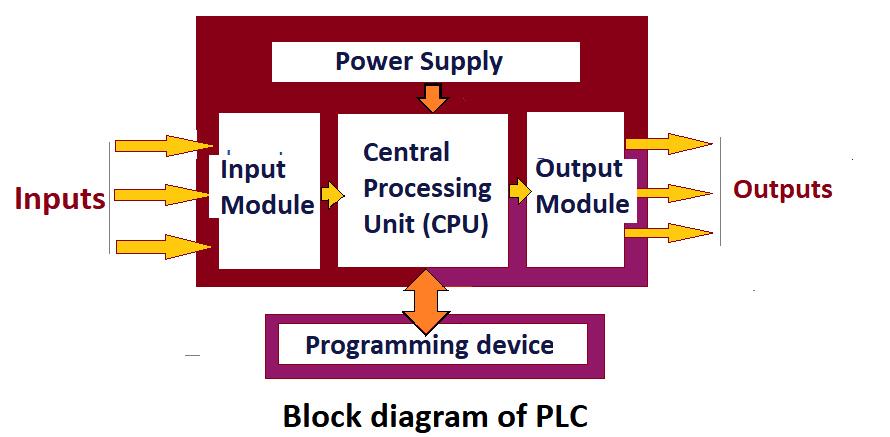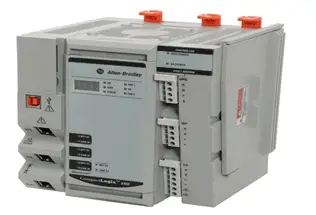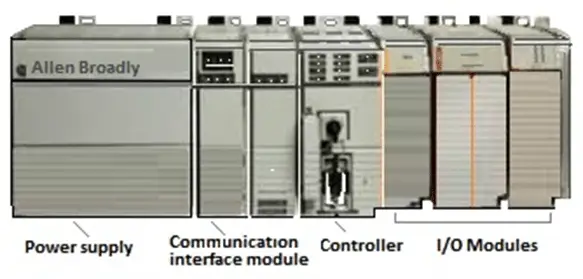In this article, we will discuss the difference between compact PLC and modular PLC. PLCs can be classified into several types based on their functions, capacities, number of I/Os, memory size, physical appearance, and others.
Who invented PLCs?
Dick Morley is believed by many to be the father of the programmable logic controller (PLC). His involvement in the creation of the first Modicon PLC for General Motors in 1968 was a historic step in the development of automation and industrial control.
A programmable controller is an electronic system designed for industrial applications. Using a programmable memory, it implements specific solutions such as logic functions, sequence, timing counts, and arithmetic functions in order to control via inputs and outputs.

A typical PLC consists of five main parts:
- Rack or chassis – on which modules are mounted.
- Power module – supply power to CPU and input, and output modules in the rack.
- Central Processing Unit (CPU) – It performs logic, arithmetic, and sequencing operations
- Input and output module -It receives inputs from the field and also outputs to the field devices. It has wiring for input and output devices.
- Communication interface module –I/O modules in one or more racks are connected with the interface module.
The PLC rack or chassis is the most important module in all PLC systems and servers as the system’s backbone.
Due to their characteristic simplicity and flexibility, programmable logic controllers are most suitable for a wide range of industries. It is possible to adapt PLC for a wide range of environments and tasks, they are also so simple that technicians who do not have prior programming experience can learn quickly.
There are two types of PLCs on the basis of the I/O modules extension facility.
- An I/O module in compact PLCs has a fixed capacity.
- An I/O module in modular PLC does not have a fixed capacity, it is possible to increase modules.
Now we will discuss what is compact & modular PLC in order to understand the difference between compact PLC and modular PLC.
Compact PLC
A compact PLC is a controller whose initial configuration cannot be altered over time because all its components are integrated into the unit.

Integrated systems combine CPU, Power Supply, input, and output modules in a single package. The compact PLC fits into a single unit the CPU, I/O, battery, memory, and sometimes even the power supply, cabling, and software are all integrated into a single machine when it is used in small applications.
A fixed number of digital IOs (no more than 30), one or two communication channels (for programming the PLC and connecting the field buses), and HMI are usually included.
In addition, there may be an input for the high-speed counter and one or two analog IOs. To increase the number of IOs of an individual compact PLC, the modules that can be connected are (further) increased. These are placed in a package, similar to that of the PLC itself. As a replacement for relays, compact-type PLCs are used in every industry.
Modular PLC
Modular PLC is a type of PLC that allows for multiple expansions of the PLC system through the use of modules, hence the term “modular”. This type of PLC is ideal for larger applications. The modules that make it up can be those of motherboard, CPU, memory, input module, or output module (or mixed). The inputs and outputs, depending on the need, will be digital or analog.

It is the most complex type of PLC as it can support thousands of inputs and outputs. Additionally, it also has the previous ones with the power supply, CPU, the input and output modules. In comparison with compact PLCs, it is the most powerful type of PLC.
The CPU, Power supply, Communication module, and other modules are usually in separate packages on a DIN rail or on a rail with Programmable Logic Controllers (PLC) with the CPU through a bus system.
Generally, the modular PLC will have a limited number of module slots, but in most cases, this can be increased. In addition, modular PLCs can use a large number of inputs, and outputs, can support larger programs, store more data, and operate under multitasking mode. Normally, they are used for control, regulation, positioning, data processing, manipulation, communication, motorization, web services, etc.
Advantages of a Modular PLC
- A modular type of PLC allows its capacity to be scaled, a good solution to meet changing demand for processes that are intended to increase their complexity over time.
- The benefits of modular PLCs outweigh the cost.
- Modular PLCs offer simpler troubleshooting, reducing system downtime.
Disadvantages of Modular PLC
- Generally, the disadvantage is that its price in the market is higher than that of a compact PLC.
- Because of its flexibility in its configuration, its programming is sometimes more complex than a compact PLC.
Advantages of a Compact PLC
- Usually, it’s programming, as it does not have more internal variables, its programming is eventually simpler than that of a Modular PLC.
- This PLC, due to its restrictions, compact PLC may be the most economical option for a particular application requirement of a machine.
Disadvantages of a Compact PLC
- By not having the possibility of expanding its capabilities, it greatly restricts its applications in requirements.